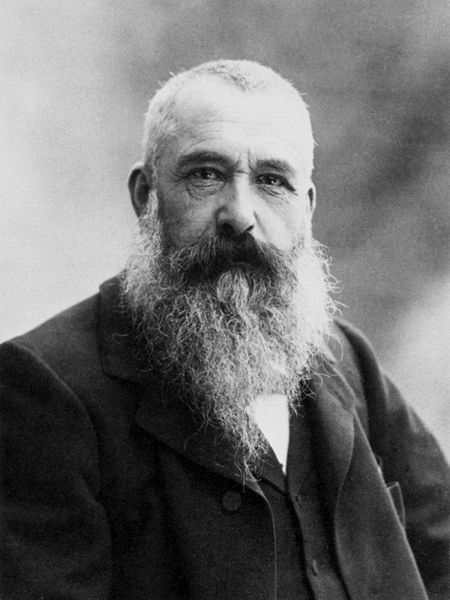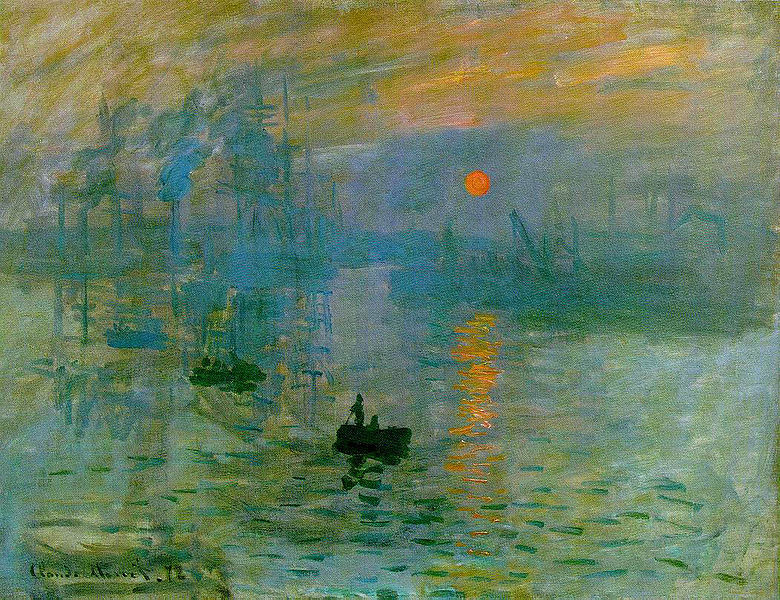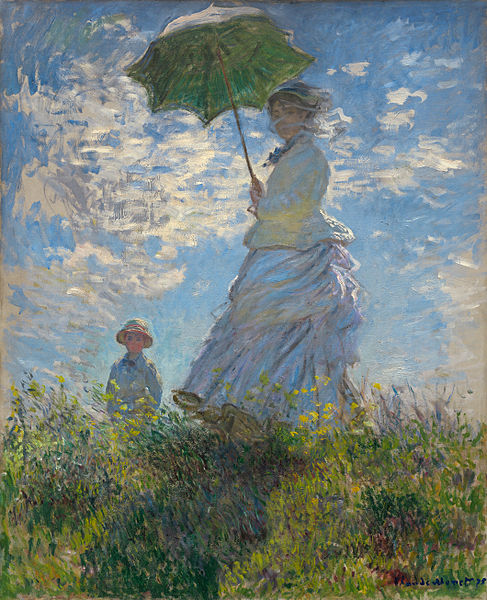| Claude Oscar Monet | |
|---|---|
 |
|
| Born | Oscar Claude Monet Nov. 14 1840 Paris, France |
| Died | Dec. 5, 1926 (at age 86) Giverny, France |
| Nationality | French |
| Movement | Impressionism |
| Field | Painter |
Monet was born November 14, 1840 on 45 rue Lafitte, in the Ninth Arrondissement of Paris. He was the second son and was baptized at the Notre-Dame of Lorette. His dad wanted him to go into the family grocery business, but he refused. On April 1, 1851, he enrolled at Le Havre Secondary School for arts. To earn money, he sold caricatures for 10-20 francs. His first apprenticeship was to Jacques-François Orchard, a former student of Jacques Louis David. Eugène Boudin taught him how to use oil paints, and introduced him to painting “en plein air.”
On January 28, 1857, his mom died when he was 16. Monet was sent to live with his widowed aunt, Marie-Jeanne LeCadre. He frequently traveled around Paris, and the Louvre. On one of his many trips, he met Éduard Manet, who he became good friends with.
In June of 1861, he joined the first regiment of the African Light Calvary in Algeria. He lasted two years out of his seven year contract. Monet contracted Typhoid, and his aunt got him out, as long as he agreed to take art lessons. Instead of going to a school like she wanted him to, he took private lessons with Charles Glyne. Monet became friends with another student of Charles, Augustus Renoir.
 Claude’s first major painting that brought him recognition in the art world was La Femme à la Robe Verte, finished in 1866. The girl in the picture, Camille Doncieux, would soon become Monet’s wife. In 1868, Camille gave birth to Jean, a son. Monet was in no shape to be a father, and tried to commit suicide by drowning himself in the Seine River. His financial state was tumultuous, for he hadn’t become the prominent artist that he wanted to be yet, and didn’t have the money to raise a family. Later on this year, he painted On the Bank of the Seine, Bennecourt, which is considered his first Impressionist painting. The focus in the work is on how water reflects light, and is composed of quick brush strokes to make it seem like it’s a passing moment. Camille is the young woman on the bank.
Claude’s first major painting that brought him recognition in the art world was La Femme à la Robe Verte, finished in 1866. The girl in the picture, Camille Doncieux, would soon become Monet’s wife. In 1868, Camille gave birth to Jean, a son. Monet was in no shape to be a father, and tried to commit suicide by drowning himself in the Seine River. His financial state was tumultuous, for he hadn’t become the prominent artist that he wanted to be yet, and didn’t have the money to raise a family. Later on this year, he painted On the Bank of the Seine, Bennecourt, which is considered his first Impressionist painting. The focus in the work is on how water reflects light, and is composed of quick brush strokes to make it seem like it’s a passing moment. Camille is the young woman on the bank.
With the outbreak of the Franco-Prussian War in 1870, the family fled to England. While there, Monet studied the landscapes of John Constable and the technique of J.M.W. Turner. On June 28, 1870, Claude married Camille at last. In May of 1871, they moved to Zaandam, North Holland. Things were going well, but for some reason the police suspected Monet of Revolutionary activity. The Monet’s returned to France that November.
 Impressionism: Sunrise was painted the next year. The work caused so much controversy that is wasn’t allowed into the exhibitions going on at the time. The painting only captures a moment in time, rather than a scene of eternity. The sun shimmers in the water, casting a bright orange glow in its path. A hostile critic is the reason this work and period is called Impressionism, and he coined the name after seeing this work. Other famous artists of the Impressionism period are Monet’s good friends, Éduard Manet, and Augustus Renoir.
Impressionism: Sunrise was painted the next year. The work caused so much controversy that is wasn’t allowed into the exhibitions going on at the time. The painting only captures a moment in time, rather than a scene of eternity. The sun shimmers in the water, casting a bright orange glow in its path. A hostile critic is the reason this work and period is called Impressionism, and he coined the name after seeing this work. Other famous artists of the Impressionism period are Monet’s good friends, Éduard Manet, and Augustus Renoir.
Camille became ill in 1876, after having their second son Michel. She died of tuberculosis on September 5, 1879. At the time, the Monet’s had been sharing a house with another family, and that woman’s husband left her about the same time Camille died. The woman, Alice Hoschedé stayed there with Monet to look after his two kids as well as her own. Monet eventually married Alice in 1899.
From 1892-1894, he did a series of oil paintings on Rouen Cathedral. They depict Rouen at different times of the day, depending on how the sun is reflecting off the Cathedral. The year he married Alice, he painted the Japanese Bridge series, for that was their garden in their backyard.
The Water Lilies Series, perhaps some of his most famous paintings, were finished shortly before his death. In his later years, he was going blind, and by the time he died, he was blind. These paintings seem very fuzzy in quality compared to some of his other works, but it’s because he couldn’t see what he was doing. Claude Monet died of lung cancer on December 5, 1926 at the age of 86. He is buried at Giverny Church Cemetery. His home and garden were bequeathed to the French Academy of Fine Arts.
One thing people forget about Impressionism is that it saved painting. The camera was developed during the previous period of Realism, and no painting can compare to the exact and fresh quality of a picture. With Impressionism, the painting isn’t meant to be an exact scene, or place;  Just a lively moment happening, not meant to stay. Monet and the other artists sort of revitalized a dying industry, giving it life when it had been almost been left to extinction.
Just a lively moment happening, not meant to stay. Monet and the other artists sort of revitalized a dying industry, giving it life when it had been almost been left to extinction.
Unfortunately, paintings by such masters like Monet have high value, and have been stolen. The piece Falaises Près de Dieppe has been taken twice. Once in 1998, where the Curator and two accomplices were jailed after they were found in possession of it, and again, in 2007, but it has yet to be recovered. Monet’s works are scattered worldwide, and almost every museum has at least one Monet in their collection to show off.
